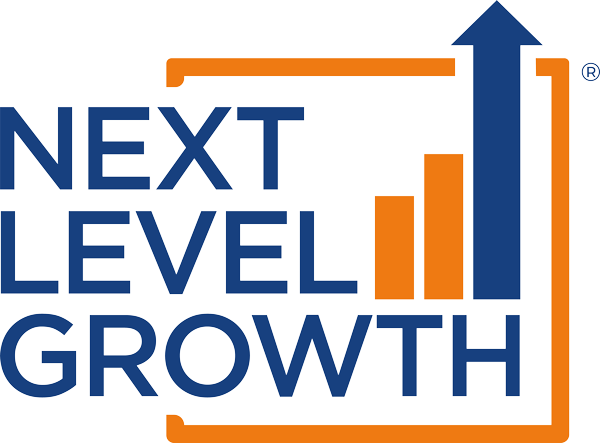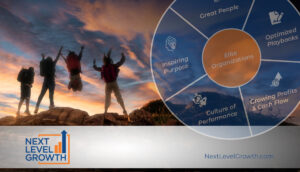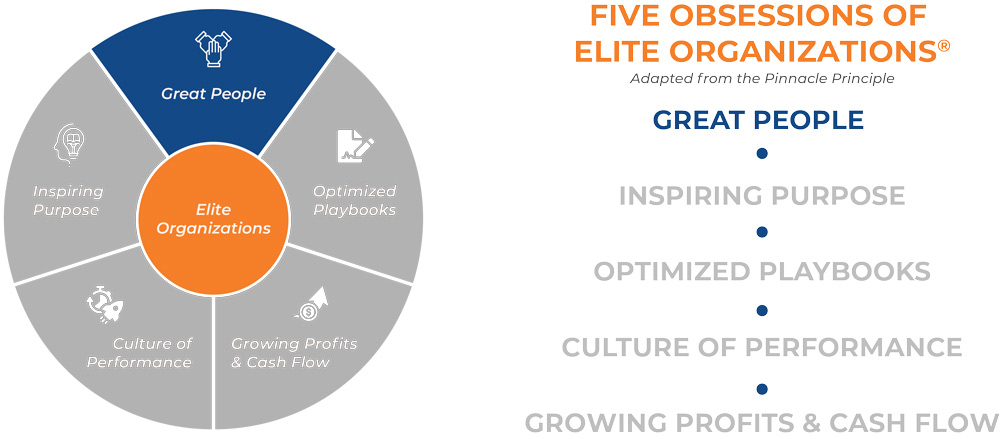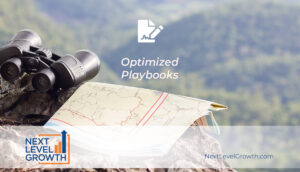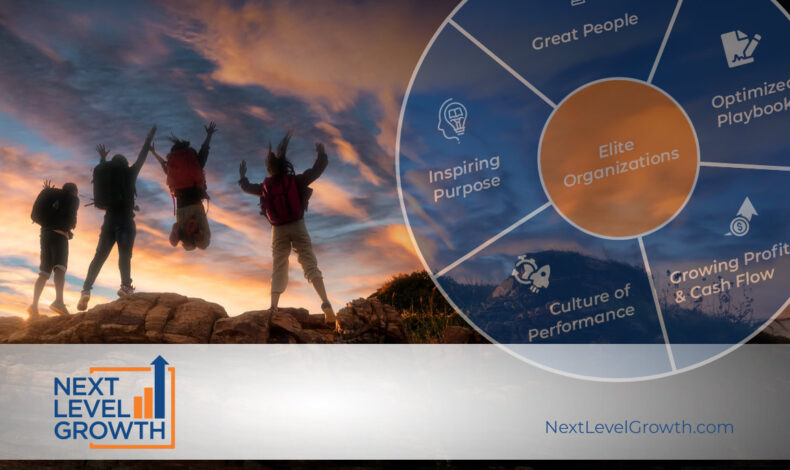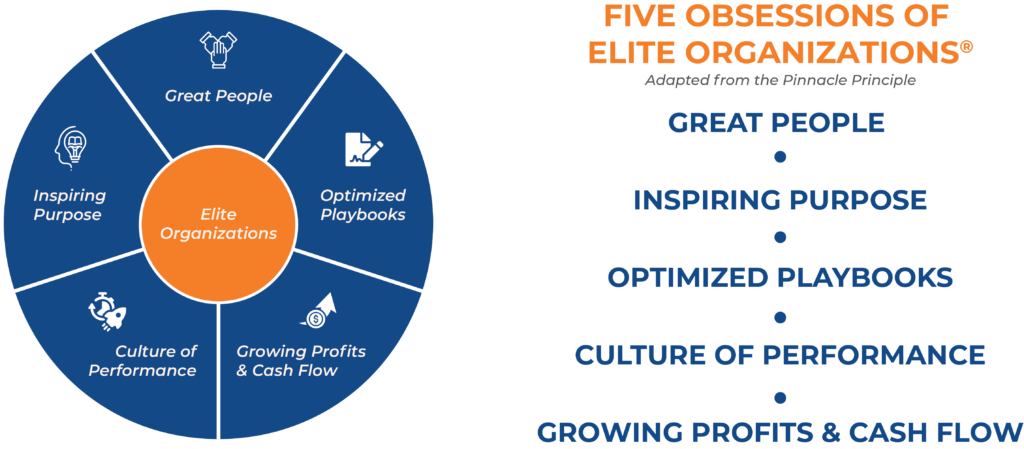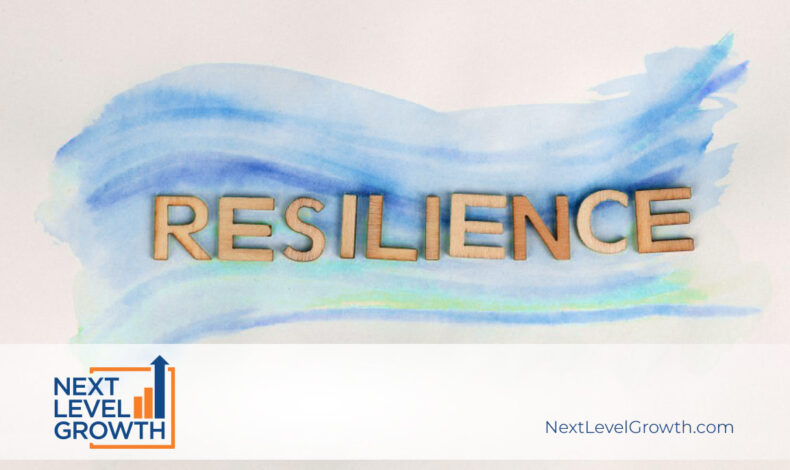Steve Jobs once said that the most powerful person in the world is the storyteller. Great stories capture our hearts and bring inspiration. When people are emotionally engaged and inspired, they will bring more discipline and passion to what they are doing. The power of the second obsession of elite organizations, an Inspiring Purpose, while often overlooked, is very real.
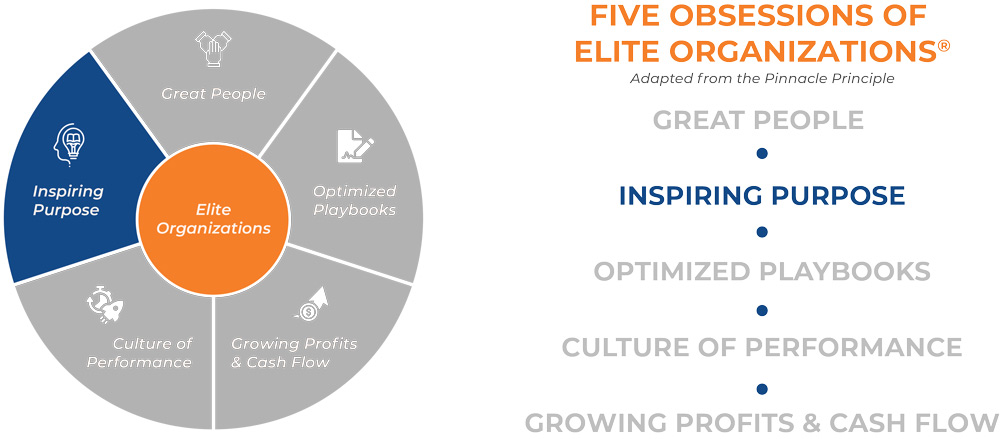
Right People, Right Seats: A Missing Piece
After nearly a decade of guiding elite entrepreneurs, and that following more than two decades of growing my own businesses, I’ve come to realize that if you are really obsessed about Great People in your organization, the “right people in the right seats” analogy from Jim Collins’ 2001 book, Good to Great, is missing one important thing. In order for people to truly be their best, they must also feel an emotional connection to an inspiring purpose behind what they do and what the organization stands for. Yes, we need our team members to share our behavioral core values. And yes, we need them to have the skillsets, experience, and desire to perform their roles at a high level. But when you add in the third element, that they form an emotional connection to their company’s Inspiring Purpose, that is when they will bring the greatest effort, drive, passion, and creativity to their role. That is when they will resist silos in the organization and collaborate best with others, because they no longer see what they do as a job, but rather as their contribution to a greater cause that inspires them.There are literally thousands of books on external marketing, and tens of thousands of consultants to help with external marketing. That is, of course, very important. But for that reason, I’m not focusing this article on external marketing. There are already lots of resources for that. This article is about what very few organizations do, and even fewer do well: internal marketing and storytelling.
Employee Engagement and an Inspiring Purpose
Think about it. What was your organization’s marketing budget last year? What percentage of it did you invest in marketing internally to your team members. What does that tell you about the value you place on inspiring and engaging your employees? What should you be investing to capture the hearts and passions of your teams?At Next Level Growth, we use a combination of concepts from different thought leaders to help our clients articulate three key pillars of their Inspiring Purpose. They are a Just Cause, a Daily Purpose, and a Strategic Niche. When we incorporate this into Jim Collins’ hedgehog concept, by including an understanding of an organization’s Profit per X (what drives their economic engine), and then also overlay the business model as a flywheel, all of the components fall into place to help every employee in an organization understand how their specific role within their Next Level Accountability Chart™ is part of a bigger picture that advances the organization’s Just Cause. It also provides a strong framework for making better decisions.
From this, many of our clients will also go on to create what Collins referred to in his book, Great by Choice, as a SMaC Recipe. SMaC stands for Specific, Methodical, and Consistent, and is defined as, “a set of durable operating practices that creates a replicable, consistent success formula.” At Next Level Growth, our SMaC Recipe is something we call our 10 Promises and clarifies how we operationalize our strategic differentiating concepts in ways that are durable and replicable. If you would like to see ours as an example, just send us a message through our website and let us know.
Daily Purpose – Start with Why
In his 2009 best-selling book, Start with Why, Simon Sinek says that “Those who truly lead are able to create a following of people who act not because they were swayed, but because they were inspired.”The second pillar of an Inspiring Purpose, but which I will speak to first, is what we call an organization’s Daily Purpose. It speaks to an organization’s “why,” it’s origin story. When working with clients, we start here because we find that the order in which we go through a discovery process matters in terms of both accuracy and efficiency. We start with Daily Purpose, then use the clarity of that Daily Purpose, or “why,” to uncover the Just Cause.
To begin to understand an organization’s Daily Purpose, we like to ask the founder why they started the company. The answer must be framed in terms of what you do with the company for the people you serve, not that you started it to make money. It should be about outcomes that you produce and that you focus on achieving every day. This often takes several rounds of questioning the answers we receive and asking “why” over and over again until we get there.
Then, we turn to the team and ask them to articulate why, beyond money, they choose to stay at the company. What is it about the work they do, what outcomes they accomplish, that brings them joy and keeps them committed to the organization.
Daily Purpose – An Example
As we work to get alignment among the answers, there is almost always an “a-ha” moment where the words become very clear. As an example, our “why,” or our Daily Purpose, at Next Level Growth is:Helping Entrepreneurial Leaders Build Elite Organizations®.
In the video above, you will hear Nick Saban talking about what it takes to be elite. This is something we focus on with our clients at Next Level Growth, and explains well the mindset that is at the core of our approach to the Five Obsessions of Elite Organizations®.
As we see leadership teams come together and build something great, something that people want to be a part of, when we see them use the tools and concepts we teach them to overcome their biggest challenges, that is what brings us the greatest joy. This is the outcome we drive that inspires us on a daily basis.
In 2019, ten years after publishing Start with Why, Sinek published The Infinite Game. In this book, he introduced the idea of a Just Cause. As we began to understand and discuss the concept at Next Level Growth, we saw Just Cause as a key and missing piece to telling an inspiring story and one which would elevate Jim Collins’ Hedgehog Concept into what we call an Inspiring Purpose.
Just Cause
Simon Sinek describes a Just Cause as a “specific vision of a future state that does not yet exist; a future state so appealing that people are willing to make sacrifices in order to help advance toward that vision.” He goes on to say, “A Just Cause is not the same as our WHY. A WHY comes from the past. It is an origin story…A Just Cause is about the future and defines where we are going. It describes the world we hope to live in and will commit to help build.”
To summarize, it is a core belief around which an organization is built, and often starts with a phrase like, “We envision a world where…,” or, “We believe that…”
Just Cause – An Example
At Next Level Growth, our Just Cause stems from my own personal belief as its Founder. This belief was something that formed in me slowly over nearly 2 decades as the owner of a family manufacturing business in the hardwood veneer industry with 200 employees, and as a member in YPO and EO, with additional time spent in VISTAGE, where I got to know and observe hundreds of other entrepreneurs. What I realized during those years, is that most entrepreneurs achieve success, to some degree, at the expense of their relationships, their time with family, their physical health, or emotional health.
During my own entrepreneurial journey, I have experienced each of those things, and it almost cost me my marriage and family, something I wrote about in my 2017 best-selling book, RISE: The Reincarnation of an Entrepreneur. It was this understanding that helped me form and articulate the belief, or Just Cause, that drives us all at Next Level Growth:
We believe entrepreneurs deserve more than a return on investment from their business, they deserve to earn a meaningful return on life.
While the thought that one day every entrepreneur will experience a meaningful return on life is not realistic, a Just Cause is about a belief you hold so strongly, you will commit your career towards its advancement. I firmly believe that Next Level Growth has the opportunity to have a significant impact in advancing this Just Cause through at least the organizations we are able to work with and help. At the end of the day, it is the successes that our clients experience on their journey to what I like to call, “entrepreneurial freedom,” and sharing those stories among our team of elite Business Guides, that motivates and inspires us to do more, to dream bigger, and to push ourselves to learn, grow and evolve.
Connecting the dots between our Just Cause and our Daily Purpose in a clear way is very important internally to keep people focused on how they need to show up every day, and what, at the end of the day, matters most. When we put these two statements together, we have the foundation of our Inspiring Purpose:
We believe entrepreneurs deserve more than a return on investment from their business, they deserve to earn a meaningful return on life. This drives our Daily Purpose of Helping Entrepreneurial Leaders Build Elite Organizations®.
When we fully understand the interplay between these two statements, and when we both celebrate the wins we accomplish and use the failures as feedback from which we can learn and grow, we have a unifying and common focus that motivates our decisions and actions on a daily basis.
Our Just Cause and Daily Purpose, and the way we articulate them, is important because it ties directly to our Strategic Niche, which I will go into shortly. Our Daily Purpose is about an outcome, a result. Our focus is on helping build elite organizations, no matter what that takes. By maintaining a daily focus on how our clients are doing on their journey to build something elite, and not on how purely they are following a prescriptive system, our Guides are able to use their experience and our collective knowledge to improvise and seek out solutions, regardless of the source of those solutions.
When we “rope in” with a client, and this is something I repeat often inside our organization, we have to obsess about how they are performing and how they are doing at a deep level, and that is how we have to show up every day. When we do this well, and consistently, our clients win, and in turn, we win.
Strategic Niche
In Jim Collins’ “Hedgehog Concept,” he refers to an organization’s niche as “what you can be best in the world at.” While Collins was researching large, publicly traded companies who perhaps could be best in the world, most entrepreneurial organizations likely won’t achieve “best in the world” status. In our experience, when that is the underlying question an entrepreneur is faced with in clarifying their strategic niche, they often struggle. For that reason, we prefer to use Michael Porter’s definition of a strategic niche: At what can you provide consistent, differentiated value in the marketplace?
When this answer becomes clear, and when you can show how it advances your Just Cause, it drives an incredibly powerful focus.
Strategic Niche – An Example
When we look at our own business, and survey the landscape of what exists in the world of business coaching and Business Operating Systems, the default is toward what we call, “one-size-fits-all” systems. While these systems often provide value for smaller companies and entrepreneurs who don’t have any systems or structures, they are usually more about the system than the user. Since breaking away from EOS® and Scaling Up, over the last few years we’ve talked to hundreds of entrepreneurs who feel that the Business Operating Systems they have tried are too rigid, or the business coaches they worked with were trying to force fit them into a system rather than making the systems fit their unique organizations.
We’ve also noticed that many Business Operating Systems have a relatively low bar for allowing people to become coaches within their system, and we think this is what drives their insistence on purity and a one-size-fits-all approach. At Next Level Growth, we only allow people who have been owners or C-Suite operators of businesses with at least ten million in revenue and fifty or more employees to apply to be a Business Guide. This level of real-world experience allows every one of our Business Guides to take a freestyle approach in working with their clients whenever it becomes necessary to achieve a desired outcome, and it protects our brand. Less capable coaches don’t have the experience to be highly flexible and meet clients where they are. They have to have a rigid system and structure, with well-defined guard rails, to fall back on.
To stand out and be different, we have formed our strategic niche around flipping this common frustration with Business Operating Systems on its head. At Next Level Growth, our Strategic Niche is:
An individualized, outcomes-based approach to customizable Business Operating & Scaling System implementation & ongoing guidance to the Summit.
Remember, a Strategic Niche should clearly define how you provide consistent, differentiated value in the marketplace. For us, there are four key differentiators.
One: Providing an individualized approach. To do this, we spend time in the discovery process getting to know and understand a potential client’s business, their ownership structure, and the unique challenges they face. We will often times pair them with a Next Level Growth Business Guide who has experience either in the same industry, or in a near-similar industry so that we can provide more unique insights and guidance.
Two: Taking an outcomes-based approach. While we have recommendations of best practices and offer key foundational concepts, not all tools and concepts work in all cases. If something we teach a client isn’t working for them, we seek out alternative solutions and work with them to achieve the outcome, not reteach the same tool or concept and hope they will get a different outcome.
We also challenge our clients to be accountable and do the work. If, over time, we feel that a client is not as committed to their own success as we are, and that they are not doing the work, we will call the end of an engagement and free up our capacity to work with someone who will be more committed and accountable. In my eight years as a Business Guide, I have personally fired four clients simply because they were not willing to do the work and were satisfied with being average to good rather than excellent or elite.
Three: As a result of our outcomes-based approach, our clients do end up with a Business Operating System, but one that is custom tailored to them and to their unique needs and circumstances. Everything fits better when it is custom-tailored.
Four: Because of our own experiences scaling our own businesses, for the clients who want us to remain roped in with them long-term, we are equipped to grow and evolve with them, continuing to provide significant value to them much longer than a typical business coach who can only teach them a certain set of tools and then runs out of value to add. As a testament to this, we have clients that are now in their 8th consecutive year of working with a Next Level Growth Business Guide, and we’ve only been in business for eight years. If we were not providing significant value, they would not be staying with us.
Inspiring Purpose – Pulling it All Together
So, when we put it all together, and frame it as a short message to not only clarify how we are unique to the marketplace, but also what we must focus on internally and why it matters, we have the statement that:
At Next Level Growth, we believe entrepreneurs deserve more than a return on investment from their business, they deserve to earn a meaningful return on life. This drives our Daily Purpose of Helping Entrepreneurial Leaders Build Elite Organizations® by providing an individualized, outcomes-based approach to customizable Business Operating & Scaling System implementation & ongoing guidance to the Summit.
This short paragraph defines the foundation of our unique business model and value proposition, and for those who are the right fit to be part of our organization, it provides inspiration and speaks to the essence of what incites passion in us all. As we make strategic decisions, we always weigh them against this Inspiring Purpose and ask ourselves, “If we choose A versus B, or it we move forward with something or choose not to, will it accelerate our momentum towards advancing our Inspiring Purpose, or might it distract us and cause us to dilute our focus?”
Please don’t overlook the importance of an Inspiring Purpose for your organization. Follow the steps above to discover and wordsmith your own, and if you would like help, we’re just a phone call or email away.
Click to read the next article in this series, Optimized Playbooks.
Next Steps
- If you have missed any of the articles in the series, click below to catch up:
- Start a conversation with us today to learn about our unique approach to taking your business, and your life, to the Next Level.
